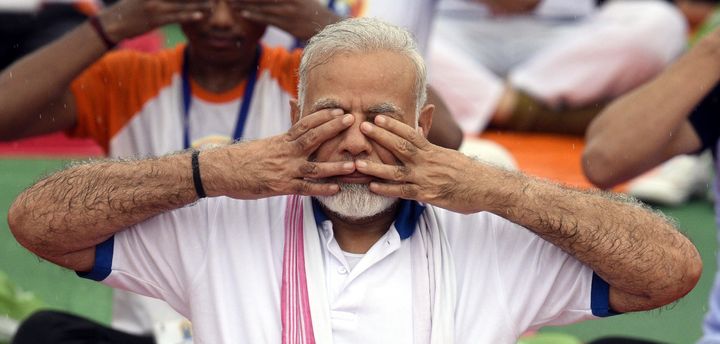
On Wednesday evening, India’s Chief Statistician Pravin Srivastava told HuffPost India that the National Sample Survey Office’s (NSSO’s) periodic labour force survey (PLFS) would take “at least a month” to be made public as data for December was still being analysed.
On Thursday morning, Business Standard’s Somesh Jha published a scoop based on numbers from the ‘missing’ report which showed that India’s unemployment rate stood at a whopping 45-year high of 6.1% in 2017-18.
This was the first annual household survey of the NSSO, conducted for the period July 2017-June 2018, as well as the first comprehensive study on jobs by a government agency after Prime Minister Narendra Modi’s controversial demonetisation announcement in November 2016.
The last two non-government members of the National Statistical Commission (NSC) had resigned earlier this week, partly because of the government’s refusal to release the report, which the body had approved in December. This had led to speculation that the government was deliberately not releasing the NSSO report as the numbers were embarrassing.
On Wednesday, the Ministry of Statistics & Programme Implementation had denied this in a statement, saying that the report would be released once quarterly data between July 2017 and December 2018 had been processed.
Himanshu, associate professor at Jawaharlal Nehru University, told HuffPost India that the PLFS has two parts, rural and urban, with different reporting frequencies—annual for rural and annual plus quarterly for urban.
“Even if the government was still processing quarterly estimates for urban areas, it would have the data from July 2017-June 2018. The NSC, the final adjudicating authority, had approved this report in December 2018. The government’s argument that the report was not ready is misleading,” he said.
Brewing jobs crisis
The question of jobs will be one of the biggest factors that will decide whether the Modi government will be able to return to the helm for a second time after the general election later this year.
The government has been unable to keep its lofty promises of providing meaningful jobs to all, and policy missteps like demonetisation have only exacerbated the crisis in the Indian economy.
On Wednesday itself, Modi said at a programme in Gujarat that the note ban had brought down prices of houses, making them more affordable for young people.
A Hindustan Times report published on Thursday pointed out that not only did demonetisation not achieve its primary objective of purging black money, it also did significant damage to the Indian economy by squeezing incomes and liquidity.
To be sure, the NSSO numbers do not come as surprise. There had been several indicators that a serious job crisis was brewing.
In September 2018, economists from Azim Premji University released a report which said that in 2015, the headline rate of unemployment reached 5%, with youth unemployment at a very high 16%. This was the highest unemployment rate in India in the last 20 years.
The report had primarily relied on data from NSSO and the Labour Bureau’s Employment-Unemployment Survey.
Himanshu had written in Mint in September 2017 that there was a sharp deceleration in real wages for both agricultural and non-agricultural sectors since 2013-14.
“The deceleration in real agricultural wages and a real decline in non-agricultural wages not only confirm the worsening demand situation in rural areas but also confirm the lack of job creation in rural areas,” the article said.
At the beginning of this year, the Centre for Monitoring Indian Economy (CMIE) released preliminary estimates that there were 11 million more unemployed people in India by the end of 2018. Its managing director Mahesh Vyas told HuffPost India’s Akshay Deshmane in an interview that the rise in the numbers of the unemployed, which began in December 2017 and continued a year later, was attributable to the twin shocks of demonetisation and GST.
Why the data is missing
In July 2018, Modi said that the problem was not a lack of jobs, but rather, lack of data on jobs.
“Our opponents will naturally exploit this opportunity to paint a picture of their choice and blame us. I don’t blame our opponents for blaming us on the issue of jobs, after all no one has an accurate data on jobs. Our traditional matrix of measuring jobs is simply not good enough to measure new jobs in the new economy of New India,” he said in an interview to Swarajya magazine.
Business Standard’s Jha had revealed in an 11 January report that according to the Labour Bureau’s Sixth Annual Employment-Unemployment Survey, unemployment rate was at a four-year high in 2016-17. In what now looks like a pattern, the report had been approved by the labour minister in December but not released to the public.
“There is no doubt that there is a serious employment problem in India. One way in which the government is dealing with the problem is by just not releasing data,” said Himanshu.
Reports from the ground also bear this out. The government’s much-vaunted Stree Swabhiman scheme, which aimed to boost women’s incomes by training them to set up small-scale sanitary napkin manufacturing units, has actually plunged many rural women into debt, HuffPost India’s Rachna Khaira reported earlier this month. This was a scheme tailor-made for the “new India” Modi claims his government has ushered in.
After the Business Standard report, some commentators have already begun to argue that the startling NSSO numbers need to be read with “nuance”. Now will the government follow suit and release a “nuanced” clarification?